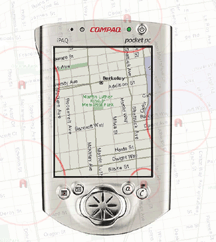halo
|
up patrick baudisch |
| halo try it out (flash)! video WMV (24M) publications poster at UIST'04 |
As users pan and zoom, display content can disappear into off-screen space, particularly on small-screen devices. The clipping of locations, such as relevant places on a map, can make spatial cognition tasks harder. Halo is a visualization technique that supports spatial cognition by showing users the location of off-screen objects. Halo accomplishes this by surrounding off-screen objects with rings that are just large enough to reach into the border region of the display window. From the portion of the ring that is visible on-screen, users can infer the off-screen location of the object at the center of the ring. We have conducted a user study comparing Halo with an arrow-based visualization technique with respect to four types of map-based route planning tasks. When using the Halo interface, users completed tasks 16-33% faster, while there were no significant differences in error rate for three out of four tasks in our study.
|
Get the
Flash Player to see this player.
|
